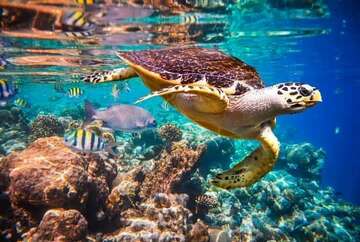Fish
Species | Group of Species
Fish, any of approximately 34,000 species of vertebrate animals (phylum Chordata) found in the fresh and salt waters of the world. Living species range from the primitive jawless lampreys and hagfishes through the cartilaginous sharks, skates, and rays to the abundant and diverse bony fishes. Most fish species are cold-blooded; however, one species, the opah (Lampris guttatus), is warm-blooded.
The term fish is applied to a variety of vertebrates of several evolutionary lines. It describes a life-form rather than a taxonomic group. As members of the phylum Chordata, fish share certain features with other vertebrates. These features are gill slits at some point in the life cycle, a notochord, or skeletal supporting rod, a dorsal hollow nerve cord, and a tail. Living fishes represent some five classes, which are as distinct from one another as are the four classes of familiar air-breathing animals—amphibians, reptiles, birds, and mammals. For example, the jawless fishes (Agnatha) have gills in pouches and lack limb girdles. Extant agnathans are the lampreys and the hagfishes. As the name implies, the skeletons of fishes of the class Chondrichthyes (from chondr, “cartilage,” and ichthyes, “fish”) are made entirely of cartilage. Modern fish of this class lack a swim bladder, and their scales and teeth are made up of the same placoid material. Sharks, skates, and rays are examples of cartilaginous fishes. The bony fishes are by far the largest class. Examples range from the tiny sea horse to the 450-kg (1,000-pound) blue marlin, from the flattened soles and flounders to the boxy puffers and ocean sunfishes. Unlike the scales of the cartilaginous fishes, those of bony fishes, when present, grow throughout life and are made up of thin overlapping plates of bone. Bony fishes also have an operculum that covers the gill slits.
Subject ID: 80761
MoreFish, any of approximately 34,000 species of vertebrate animals (phylum Chordata) found in the fresh and salt waters of the world. Living species range from the primitive jawless lampreys and hagfishes through the cartilaginous sharks, skates, and rays to the abundant and diverse bony fishes. Most fish species are cold-blooded; however, one species, the opah (Lampris guttatus), is warm-blooded.
The term fish is applied to a variety of vertebrates of several evolutionary lines. It describes a life-form rather than a taxonomic group. As members of the phylum Chordata, fish share certain features with other vertebrates. These features are gill slits at some point in the life cycle, a notochord, or skeletal supporting rod, a dorsal hollow nerve cord, and a tail. Living fishes represent some five classes, which are as distinct from one another as are the four classes of familiar air-breathing animals—amphibians, reptiles, birds, and mammals. For example, the jawless fishes (Agnatha) have gills in pouches and lack limb girdles. Extant agnathans are the lampreys and the hagfishes. As the name implies, the skeletons of fishes of the class Chondrichthyes (from chondr, “cartilage,” and ichthyes, “fish”) are made entirely of cartilage. Modern fish of this class lack a swim bladder, and their scales and teeth are made up of the same placoid material. Sharks, skates, and rays are examples of cartilaginous fishes. The bony fishes are by far the largest class. Examples range from the tiny sea horse to the 450-kg (1,000-pound) blue marlin, from the flattened soles and flounders to the boxy puffers and ocean sunfishes. Unlike the scales of the cartilaginous fishes, those of bony fishes, when present, grow throughout life and are made up of thin overlapping plates of bone. Bony fishes also have an operculum that covers the gill slits.
Subject ID: 80761
Subject ID: 80761
